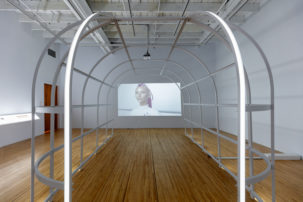Have you ever stopped to wonder why we use the terms work of art or artwork? These turns of phrase suggest there is an exquisite inextricability between art and work, and they imply there is something markedly different about creative labour. Now, three artists consider the vexed relationship between art and work in playful, arduous and enduring contemplations at SAVAC’s Annual Juried Members’ Exhibition—aptly entitled “Work It.”—at Gallerywest in Toronto.
Crawl (2014) by Alize Zorlutuna documents the artist “crawling” backwards up recognizable “starchitect”-designed staircases at the Art Gallery of Ontario and the Royal Ontario Museum. While crawling typically signals a nascent freedom for infants, Zorlutuna’s endeavour is onerous, mirroring the challenge of building a successful art career—the oft-believed barometer for which is inclusion in the collections of such exalted institutions, against exclusionary odds.
Likewise, Umber Majeed digitally intervenes onto painterly surfaces, placing herself in Frida Kahlo’s The Two Fridas and generic painting styles like the still life to bypass the pomp and process of art canonization, which can turn a blind eye to the depth of an artist’s commitment, relying instead on temperamental assertions of value based upon certain privileges.
Basil AlZeri’s installation You Do What You Love Because You Do One, Two, and More Than Two (2014) considers the auxiliary work necessary to sustain an art practice. Making reference to Micah Lexier’s exhibition “One, and Two, and More Than Two” that took place at the Power Plant last year—which included Lexier’s display of more than 200 artworks by 101 artists/duos/collectives in and around Toronto—AlZeri’s installation consists of 120 objects from 101 artists representing their jobs outside their art practice. Unlike Lexier’s meticulous, clean-white vitrines, AlZeri’s installation offers a glimpse of the workaday things that artists do to pay the bills.
While “quotidian” might be the perfect overused art word to describe AlZeri’s arrangement, the term falls short of relaying the intricate and poetic nature of the objects involved. A pile of lockets—some opened—represent that Jess Dobkin is “For Hire”; David Khang describes his occupation as a dentist with an extracted molar replete with a tiny, painted red heart; a single worn-out Blundstone stands for Joshua Vettivelu’s multiple jobs as instructor, installer, server (fired), and customer service (also fired); and a heap of ground espresso, waywardly creeping toward neighbouring objects, tells of Anni Spadafora’s barista life. Diane Borsato, a mother and self-described “host,” marries the oft-undervalued labour of both child-rearing and artmaking; her simple red teapot poignantly stands for their shared campaign for legitimacy.
In a time of ruthless funding cuts, dizzying demands of late-capital mega-productivity, and ubiquitous post-grad baristas, AlZeri’s installation exposes the inherent precarity of labouring on something loved, the fissures of legitimation that such labour endures, and the ways in which we have to “work it,” just to make it work.









